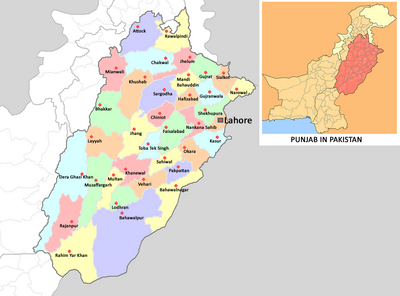Rahim Yar Khan


Rahim Yar Khan (Hindi:रहीम यार खान,Urdu: رحیم یار خان) is a city and district in the Punjab province of Pakistan.
Tahsils in the District
Jat Gotras
Click to see Jat Gotras in Rahim Yar Khan
History
Early History: Alexander was the warrior and conqueror when he entered Multan the City which is known by its Saints. He Appointed One of his Famous General Phillipos to Rule the Area. Rahim Yar Khan and Neighboring Cities Came under Alexander Successors Rule. His Rule was Spread from the City of Multan Till Sukkur (then known as Poros) He was Challenged by Raja Poros in the Battle of Poros and got defeated. With this the Alexander Era Came to an End.
Buddhism Era - The Buddhist Empire was headed by Asoka. During his quest of power he invade almost whole of the subcontinent. His influence in this Area is still unknown to many but it is believed that Rahim Yar Khan was the Part of His Empire before 493 A.D.
Rai Dynasty - Rai Dynasty belongs from the Sindh and they came into power around 493 A.D. Raja Divaji of Rai Dynasty was the Ruler. He Developed the System of Districts and Towns in his era. Rai Dynasty Ruled almost 150 yrs in the surrounding area including Sindh and Current Cities like Multan, Bahawalpur, Rahim Yar Khan.
Brahman Era - Brahman’s Era is widely recognized by one of its strongest Kings Raja Dahir, But Brahmans came into power after the Death of King Rai Sahiras II of Rai Dynasty. Brahman Chach Married his widow and came into power. The Brahman Chach belonged to the current known city of Chachran Shariff.The Last Ruler of Brahman Era was the Strongest Raja Dahir.Raja Dahir was Over Thrown by Arabs.
Arabs and Islamic Era - Arabs were trading to the Far East in that era. It is a known history that Raja Dahir people attacked some of the Arabs Merchants and their Ships. This gives a change to the history of subcontinent the Caliph of Baghdad Hajaj Bin Yusuf Sent his commander Mohammad Bin Qasim to free the Arab merchants from Raja Dahir. Mohammad Bin Qasim entered in this area to free the people but his invasion continues and travels to South and north of Punjab till Multan and beyond. Arab ruled the land from 712 A.D till 871 A.D. Islam flourishes as a religion in their era. The Arab Ruling families at that time was Abbasids and Umayyad in the Arab World and their Kingdom was stretch from Subcontinent to Spain.
Yemini Dynasty: Yemini dynasty is of Turkish origin and included large extent of Persia and Northern India. Mahmud of Ghazni was the crowned ruler of this empire though it was founded by Sebuktigin. Sebuktigin`s son Mahmud, expanded the empire that stretched from the Oxus River to the Indus Valley and the Indian Ocean and in the West too. Mahmud Invade the Somnath Temple and after that Appointed Karamatian people to the Thrown. The Yemini Dynasty in Subcontinent was under the influence of Abbasid Caliph Abdul Abbas Al Hakim. In 1366 AD Amir Sultan Ahmed II migrated from the Egypt to Subcontinent and settled in the Derawar Fort Area. They were succeeded by Moguls and Ghauris.
Duddees Influence - In 1540, Duddees (Daudpota Family of Pakistan) a well-known tribe rose to considerable power in the eastern part of Bahawalpur. Amir Bahadur Khan Abbasi, the chief of Daudpota then came to power him and his descendants wielded small principalities of Bahawalpur State into a united kingdom. Amir Muhammad Mubarik Khan I, Abbasi who came to power in 1702 was an able commander and leader. Throughout his reign he had to fight many battles against Kalhoras. He abdicated in 1723 A.D., in favor of his son Sadiq Mohammad Khan I. Sadiq Mohammad Khan I (1723-1746) was killed in a battle with Khuda Yar Khan Kalhora. Amir Mohammad Bahawal Khan I, (1 746-1 949) ascended the throne in 1746. During his short rule, he built the towns of Bahawalpur, Qaimpur, Hasilpur, Tranda Ali Murad Khan, Shahbazpur and Mohammadpur Laman.
On the death of Amir Bahawal Khan III. Sadiq Mohammad Khan III, (1852-1853) was crowned as Amir. On assuming ruler ship he confined prince Haji Khan and his brothers and treated them harshly. A large number of Bahawalpur army was demobilized. All the grants, rights and claims of Daudpotas and other usual expenses were diminished and abolished. These events made the Amir unpopular. On the 29th of Rabi-ul-Sani, 1269 A.H, Fateh Garh Fort was attacked at night. Prince Haji Khan, who was kept as prisoner, was freed and brought to Khanpur. Haji Khan entered Ahmedpur East without any resistance and Sadiq Muhammad Khan III was imprisoned. Prince Haji Khan who assumed the title of Fateh Khan ruled the state from 1853 to 1858 A.D. Prince Rahim Yar Khan succeeded his father, the late Amir Fateh Khan Abbasi, as Muhammad Bahawal Khan IV (1858-1866). He was poisoned and died on the 25th March. I866. On the death of Amir Bahawal Khan IV, Sir Sadiq Muhammad Khan IV was crowned when he was four and half year old. He was installed in 1879 when he attained maturity In the interim period from 1866 to 1879. The state was supervised by British Officers. Amir Muhammad Bahawal Khan V, the next successor was about I6 years of age at the time of his father's death in 1907. Amir Sadiq Mohammad Khan Abbasi V (I 907-1955), was proclaimed Amir of Bahawalpur on the death of his father in 1907. He was then a child of three years old. He ruled the state till 1955 when it was integrated in the Punjab province of Pakistan.
Notable persons
References
Back to Pakistan

